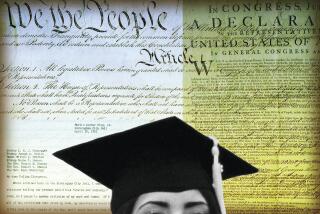Constitution’s 200th Used to Close History Gap
- Share via
PRINCETON, N.J. — Representatives from five of the 13 Colonies gathered here recently to fan enthusiasm for the bicentennial of the U.S. Constitution, and Martha Carson-Gentry was ready for them.
They came from Delaware, Maryland, New Jersey, New York and Pennsylvania, where Carson-Gentry is a high school teacher in west Chester County, and her principal has been heard to say: “I’m becoming increasingly terrified to ask her, ‘What’s new?’ ”
Carson-Gentry is a woman obsessed by the fact that most Americans don’t have the foggiest idea what the Constitution is about, and she is doing something about it.
A recent survey of U.S. adults found that almost 50% did not know that the Constitution was written to form the federal government and define its powers. In fact, 27% of those polled identified the Bill of Rights as the Preamble to the Constitution, 59% said they didn’t know what the Bill of Rights was, and 26% confused the Constitution with the Declaration of Independence.
That general ignorance is one reason the Commission on the Bicentennial of the Constitution has scheduled regional meetings to stimulate interest in the document that prescribes how our government will operate day to day, the limits of its authority and the rights that “We The People” have allowed that government.
Crusade in Classroom
The lack of knowledge of the Constitution galls Carson-Gentry, but her students are in the minority. They not only know what the Constitution is, they have lived it.
Their teacher has brought Speaker of the House Jim Wright, civil rights heroine Rosa Parks and Martin Luther King III into the classroom. She has also invited President Reagan and Lee Iacocca, although both declined because of more pressing business.
She has raised money for local contests, writes a bicentennial newsletter for the state commission on the Constitution and still finds time to teach four classes.
She also had time to come to the fourth of seven regional bicentennial meetings and to address workshops on what can be done locally to increase awareness of the Constitution at little or no expense. (The national bicentennial commission has little money to aid state and local groups.)
Carson-Gentry, a petite, graying woman, is an example of just the kind of local help the commission is looking for.
Student Radio Spots
She has her students doing radio spots on local stations. One, made by a bright-eyed Laotian girl who spoke in broken English about Benjamin Franklin, “brought tears to my eyes,” Carson-Gentry said. “It just filled your heart up and it was one of the biggest moments of her life. I could just see her sweet little face light up!”
Carson-Gentry has tapped all kinds of local resources, experts at the state university in west Chester said.
“We don’t have to be terribly astute, but there are people out there who are,” she said. “I don’t know all that much. I just call people who do. Ask them. They want to tell you what they know.”
One day in class, one of her students allowed as how his grandfather was going to be Speaker of the House, and the dauntless Carson-Gentry prevailed on the youngster to ask the representative from Texas to address the class on the Constitution.
She followed up with a letter that read, in part: “Your grandson, Eric. . . is very proud of you and on the first day of school when I was explaining. . . what our plans were, he very quickly raised his hand and told us about his grandfather. . . . It would mean a lot to your grandsons and their fellow students.”
Cites Texas Ancestor
She added: “My ancestor, Samuel Price Carson, signed the Texas Declaration of Independence and was the first secretary of state of Texas. Will that help?”
Wright replied: “Thank you very much for the invitation which Eric delivered. I am truly very much impressed with your program and would be honored to be a part of it . . . .”
What impressed Carson-Gentry was that the envelope carried a postage stamp. Wright had not used his franking privilege.
When Rosa Parks, the black woman who refused to sit in the back of the bus in Montgomery, Ala., accepted an invitation to talk to Martha’s class, guests agreed to attend. She raised $5,000 from local businesses for a luncheon to which she invited black senior citizens as well as her students.
“The students needed that exposure, and then in assembly after the luncheon, when all of the principals spoke, the students asked questions. They were extremely knowledgeable, and I was so proud!”
The national commission, headed by former Chief Justice Warren E. Burger, is mightily impressed with the way Carson-Gentry delivers her message and would like to have a thousand more like her.
College History Gap
The same day that she was holding forth to volunteers, Herbert Brownell, 84, U.S. attorney general under President Eisenhower, was addressing students at West Orange High School not far away.
“They had been studying like blazes,” he said, “and they knew their stuff. They were just as bright as could be, and asked questions interminably.” Then he visited a nearby university campus, where he ran into apathy.
“There was a hiatus in the ‘60s and ‘70s when history was not taught. It’s very evident, and I think one thing we can do, in terms of the bicentennial, is to get those courses back in the curriculum. Perhaps we haven’t done a good enough job in dramatizing the modern applications of the Constitution. Anyhow, that accounts for some spots of absolute ignorance. There’s no doubt that an awful lot of people don’t know the difference between the Declaration of Independence and the Constitution.”
Back at the meeting, Paul Clark, head of state and local programs for the commission, was summing up the problem:
Youth Survey Quoted
“In a 1984 survey of over 1,000 graduating seniors, two-thirds could not place the Civil War in a 50-year time period; 50% did not know that Columbus came to this country before the year 1750; half had not heard of Winston Churchill or Josef Stalin; 75% had not heard of Walt Whitman, Henry David Thoreau or Carl Sandburg.”
He outlined the plans for the next five years during which the commission will guide the American public through the Constitution’s signing and ratification, culminating in 1991 in a celebration of the Bill of Rights and the other 16 amendments.
He spelled out what the 800 local commissions are doing, from excerpting a 1780s Philadelphia newspaper in Indiana to moving state Supreme Court deliberations into outlying towns in Washington state and Louisiana, from living-legacy parks built by retired people to changing street names, from firehouse suppers in rural Delaware to soapbox oratory in a Philadelphia park.
More to Read
Sign up for Essential California
The most important California stories and recommendations in your inbox every morning.
You may occasionally receive promotional content from the Los Angeles Times.










